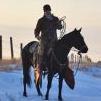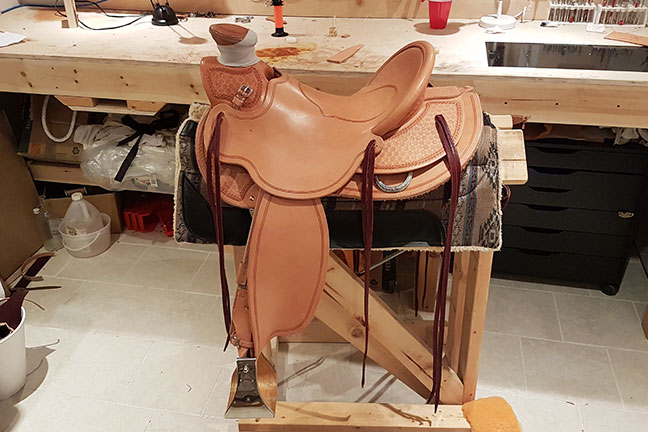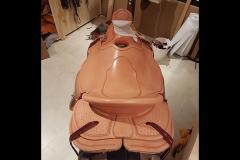-
Posts
366 -
Joined
-
Last visited
Content Type
Profiles
Forums
Events
Blogs
Gallery
Everything posted by rdl123
-
-
Hello All, Finished this saddle last weekend. It has just two coats of light oil. Specs are: 16" seat, Ben Swanke tree (4-1/4" x 90 w 5x12 cantle), Guadalajara horn, daisy stamp, 5" monels, in skirt rigged - Placed between 7/8ths and 3/4 position. Still lots of imperfections - Dented cantle sewing cantle binding - Awl snapped and I jabbed handle into dish...Also, the seat has a little too much rise to it by my eye. Wish I had of got about an extra 1/4" out up front... Look forward to any critiques folks might have - Always looking to improve my work. Thanks - Ron L
- 9 replies
-
- wade saddle
- inskirt
-
(and 2 more)
Tagged with:
-
From the album: Third Rig
-
From the album: Third Rig
-
- wade saddle
- inskirt
-
(and 1 more)
Tagged with:
-
I like the tooling in the gullet!
-
Hello Randy - I've had the tree for this saddle for quite a while - However, this one actually went quick for me - Started it in January and worked on it an hour or two on occasional evenings - So feels like it came together quick (saddle 2 took me over a year). Here is the back of the cantle binding - I'm not good at the aim and follow through that Oltoot was referring to...So I definitely end up torquing up the awl blade trying to steer it. Got my Barry King awl blades today - Look OK - So will have to see how they work! I have also attached an image of how I worked the inskirt rigging...I used 4 stainless steel screws up front and two at front of cantle and two behind cantle. Would like input on how others do inskirt rigs. I'll try to get a pic of all how i sewed it and the rivets I added for reinforcement. R
-
From the album: Third Rig
-
Josh, Must have something to do with sewing the third cantle binding! I have been using a parafin block and rubbing the awl on that - It helps it slide through easier - I was trying to really be careful on this binding and get my stitches on back to look nice - Probably put to much torque on blade trying to 'steer' it. Goldshot, Yes, I use Bob Douglas awls too - Do you know if his blades are still available what with sheridan leather closing? I ordered some of Barry King's when I snapped this one... Glad you like the lines - I've tried hard on this one to get things looking better - There's so much good help available now - Through forums like this, DVD's etc. In particular Keith Seidel has been very helpful on this forum and pointed out things on my last rig that needed attention...I also went and spent a couple hours with Chuck Stormes last summer and he really helped me...it gives amateurs like me a serious help to have that caliber of help available... I'll take some pictures of the riggings and post them for you...A little nervous mind you as I had to figure out how to do that on my own...so not sure if what I did is 100%... Hope your thumb healed up! R
-
Here is the third rig I have built - It's getting close to done now... Broke an awl blade sewing the pencil roll - Never had that happen before - I am wondering if this is a technique issue... Here are some pics. Made a decent mark in cantle dish when awl blade snapped...think i will add the daisy stamp to cantle dish to help 'camouflage' it...Anyone have suggestions? Saddle Details: Swanke Tree, 16" seat, Inskirt rigged - Rigging at between 7/8th and 3/4...Guadalajara horn (3x4.25"). Next step is to finish sewing cantle binding, oil everything up and then final assembly. Ron L
-
From the album: Third Rig
Wade on Swanke tree - Nearly done -

17626633_605621512965344_5697847904837788399_n.jpg
rdl123 commented on Leather Stash's gallery image in Gallery- Our Leatherwork
-
Hello Hannah, It looks to me like you've been given excellent advice. If you haven't already purchased a tree I would like to second Oltoots advice - Call Sonny Felkins. My last saddle was built on one of his and it is very square and very true. Also, after lots of riding and brandings this season I can say that it fits all of our quarter horses very well. I have limited experience having only built two rigs so far: However, my advice based on this limited experience is: 1) Use the best tree you can afford 2) Use the best leather you can afford. I like Hermann Oak - (I have successfully bough some of my HO from Montana Leather too) 3) Use all stainless steel or brass hardware. Nothing nickel plated. 4) take your time - If you get in a jamb better to stand back and analyse till you see your way clear I found the DVD's invaluable - I bought both Jeremiah Watts & Dale Harwoods. I think they are well worth it. If the tips they provide saves you wrecking one side of leather they pretty much pay for themselves! I think Steve Brewers all leather ground seat tutorial (pinned at start of saddle construction forum) is a good place to start for building ground seats. I used his techniques on first two saddles and have no complaints. Some of the best advice I have seen is "make it look handmade, not home made"! This info may or may not help you too: My first saddle gallery, My second saddle gallery, my first saddle forum. Good Luck & Happy Building, Ron L
-
-
http://www.mcmaster.com/#nails/=12r20yj Here's a link to the page - Thanks for the info CWR! Ron L
-

Help finding a post that had a section dwg of seat inlay
rdl123 replied to plinkercases's topic in Saddle Construction
Hello, Here is the section I drew... Not sure is this is what you were after. Also it says 1.4" foam - It should be 1/4" of foam R -
Hello Keith, Here is a pic showing what I understand of your suggestion to raise the seat ear cut higher up the cantle... Is this correct? Thanks - Ron L
- 12 replies
-
- wade saddle
- saddle number two
- (and 4 more)



















